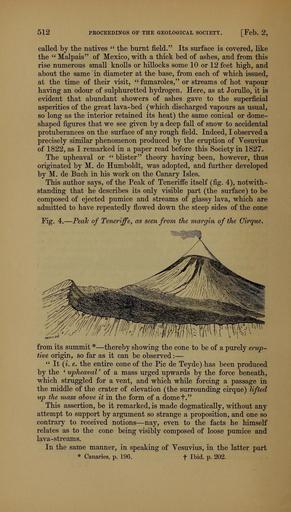MAKE A MEME
View Large Image

| View Original: | The_Quarterly_journal_of_the_Geological_Society_of_London_(12981198763).jpg (1162x2045) | |||
| Download: | Original | Medium | Small | Thumb |
| Courtesy of: | commons.wikimedia.org | More Like This | ||
| Keywords: The Quarterly journal of the Geological Society of London (12981198763).jpg 512 <br> PROCEEDINGS OF THE GEOLOGICAL SOCIETY <br> Feb 2 <br> called by the natives ' the burnt field Its surface is covered like <br> the Malpais of Mexico with a thick bed of ashes and from this <br> rise numerous small knolls or hillocks some 10 or 12 feet high and <br> about the same in diameter at the base from each of which issued <br> at the time of their visit ' fumaroles or streams of hot vapour <br> having an odour of sulphuretted hydrogen Here as at JoruUo it is <br> evident that abundant showers of ashes gave to the superficial <br> asperities of the great lava-bed which discharged vapours as usual <br> so long as the interior retained its heat the same conical or dome- <br> shaped figures that we see given by a deep fall of snow to accidental <br> protuberances on the surface of any rough field Indeed I observed a <br> precisely similar phenomenon produced by the eruption of Vesuvius <br> of 1822 as I remarked in a paper read before this Society in 1827 <br> The upheaval or blister theory having been however thus <br> originated by M de Humboldt was adopted and further developed <br> by M de Buch in his work on the Canary Isles <br> This author says of the Peak of Teneriife itself fig 4 notwith- <br> standing that he describes its only visible part the surface to be <br> composed of ejected pumice and streams of glassy lava which are <br> admitted to have repeatedly flowed down the steep sides of the cone <br> Fig 4 PeaJc of Teneriffe as seen from the margin of the Cirque <br> oei'iii <br> from its summit thereby showing the cone to be of a purely erup- <br> tive origin so far as it can be observed <br> It e the entire cone of the Pic de Teyde has been produced <br> by the ' upheaval ' of a mass urged upwards by the force beneath <br> which struggled for a vent and which while forcing a passage in <br> the middle of the crater of elevation the surrounding cirque lifted <br> up the mass above it in the form of a domef <br> This assertion be it remarked is made dogmatically without any <br> attempt to support by argument so strange a proposition and one so <br> contrary to received notions nay even to the facts he himself <br> relates as to the cone being visibly composed of loose pumice and <br> lava-streams <br> In the same manner in speaking of Yesuvius in the latter part <br> Canaries p 196 f Ibid p 202 36162079 111474 51125 Page 512 Text v 15 http //www biodiversitylibrary org/page/36162079 1859 Geological Society of London NameFound Vesuvius Biodiversity Heritage Library The Quarterly journal of the Geological Society of London v 15 1859 Geology Periodicals Smithsonian Libraries bhl page 36162079 dc identifier http //biodiversitylibrary org/page/36162079 smithsonian libraries Information field Flickr posted date ISOdate 2014-03-07 Check categories 2015 August 26 CC-BY-2 0 BioDivLibrary https //flickr com/photos/61021753 N02/12981198763 2015-08-26 14 57 00 cc-by-2 0 PD-old-70-1923 The Quarterly journal of the Geological Society of London 1859 Photos uploaded from Flickr by FĂŚ using a script | ||||